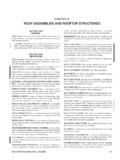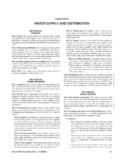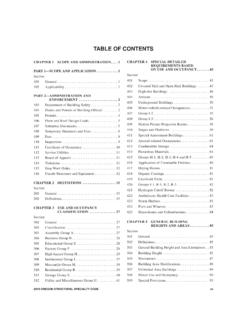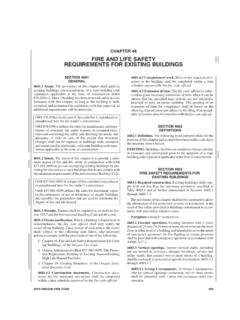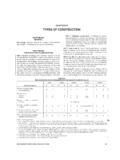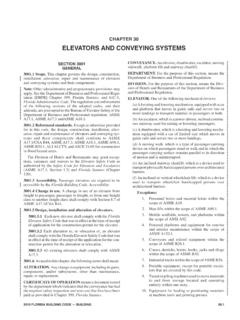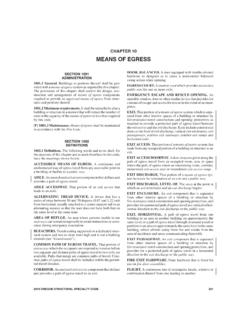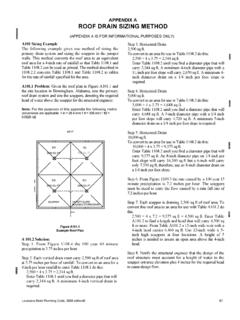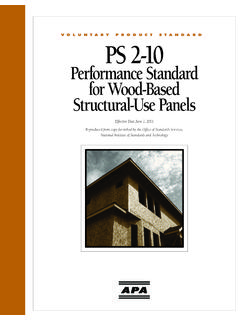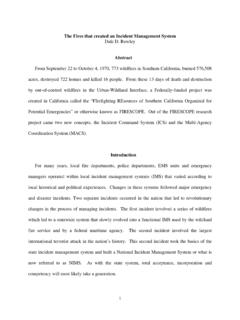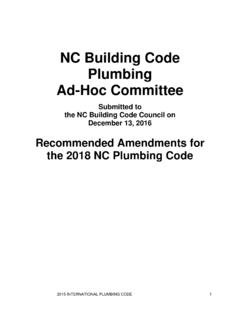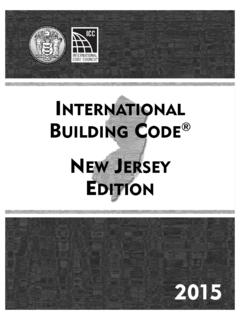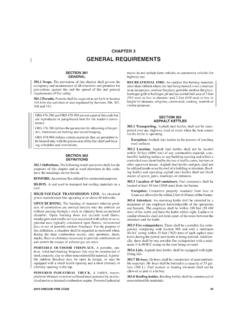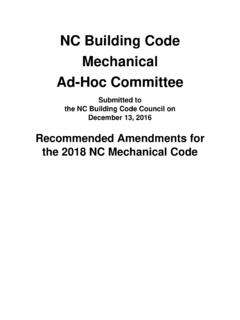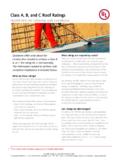Transcription of Effective Use of the International Building Code
1 Effective Use of the International Building CodeTheInternational Building code (IBC ) is a model code that provides minimum requirements to safeguard the public health,safety and general welfare of the occupants of new and existing buildings and structures. The IBC is fully compatible with the ICCfamily of codes, including: International Energy Conservation code (IECC ), International Existing Building code (IEBC ), International Fire code (IFC ), International Fuel Gas code (IFGC ), International Mechanical code (IMC ),ICC Perfor-mance code (ICCPC ), International Plumbing code (IPC ), International Private Sewage Disposal code (IPSDC ),Interna-tional Property Maintenance code (IPMC ), International Residential code (IRC ), International Wildland-Urban InterfaceCode (IWUIC ) andInternational Zoning code (IZC ).
2 The IBC addresses structural strength, means of egress, sanitation, adequate lighting and ventilation, accessibility, energy con-servation and life safety in regards to new and existing buildings, facilities and systems. The codes are promulgated on a 3-year cycleto allow for new construction methods and technologies to be incorporated into the codes. Alternative materials, designs and meth-ods not specifically addressed in the code can be approved by the code official where the proposed materials, designs or methodscomply with the intent of the provisions of the code (see Section ).The IBC applies to all occupancies, including one- and two-family dwellings and townhouses that are not within the scope of theIRC.
3 The IRC is referenced for coverage of detached one- and two-family dwellings and townhouses as defined in the Exception toSection and the definition for townhouse in Chapter 2. The IBC applies to all types of buildings and structures unlessexempted. Work exempted from permits is listed in Section and Format of the 2009 IBCB efore applying the requirements of the IBC, it is beneficial to understand its arrangement and format. The IBC, like other codespublished by ICC, is arranged and organized to follow sequential steps that generally occur during a plan review or 2 Administration and definitions3 Use and occupancy classifications4, 31 Special requirements for specific occupancies or elements5 6 Height and area limitations based on type of construction7 9 Fire resistance and protection requirements10 Requirements for evacuation11 Specific requirements to allow use and access to a Building for persons with disabilities12 13, 27 30 Building systems, such as lighting, HVAC, plumbing fixtures.
4 Elevators14 26 Structural components performance and stability32 Encroachment outside of property lines33 Safeguards during construction34 Existing Building allowances35 Referenced standardsAppendices A KAppendices2010 OREGON STRUCTURAL SPECIALTY CODEv3M:\data\CODES\STATE CODES\Oregon\2010\Structural Specialty_Building\Final VP\ , February 05, 2010 12:54:55 PMColor profile: Generic CMYK printer profileComposite Default screenThe IBC requirements for high hazard, fire-resistance-rated construction, interior finish, fire protection systems, means ofegress, emergency and standby power, and temporary structures are directly correlated with the requirements of the IFC. The fol-lowing chapters/sections of the IBC are correlated to the IFC:IBCC hapter/SectionIFCC hapter/SectionSubjectSections 307, 414, 415 Chapters 27 44 High-hazard requirementsChapter 7 Chapter 7 Fire-resistance-rated constructionChapter 8 Chapter 8 Interior finish, decorative materials and furnishingsChapter 9 Chapter 9 Fire protection systemsChapter 10 Chapter 10 Means of egressChapter 27 Section 604 Standby and emergency powerSection 3103 Chapter 24 Temporary structuresThe IBC requirements for smoke control systems, and smoke and fire dampers are directly correlated to the requirements of theIMC.
5 IBC Chapter 28 is a reference to the IMC and the IFGC for chimney, fireplaces and barbeques, and all aspects of mechanicalsystems. The following chapters/sections of the IBC are correlated with the IMC:IBCC hapter/SectionIMCC hapter/SectionSubjectSection 716 Section 607 Smoke and fire dampersSection 909 Section 513 Smoke controlThe IBC requirements for plumbing fixtures and toilet rooms are directly correlated to the requirements of the IPC. The followingchapters/sections of the IBC are correlated with the IPC:IBCC hapter/SectionIPCC hapter/SectionSubjectChapter 29 Chapters 3 & 4 Plumbing fixtures and facilitiesThe following is a chapter-by-chapter synopsis of the scope and intent of the provisions of theInternational Building 1 Scope and 1 establishes the limits of applicability of the code and describes how the code is tobe applied and enforced.
6 Chapter 1 is in two parts, Part 1 Scope and Application (Sections 101 102) and Part 2 Administrationand Enforcement (Sections 103 116). Section 101 identifies which buildings and structures come under its purview and referencesother ICC codes as applicable. Standards and codes are scoped to the extent referenced (see Section ).The Building code is intended to be adopted as a legally enforceable document and it cannot be Effective without adequate provi-sions for its administration and enforcement. The provisions of Chapter 1 establish the authority and duties of the code officialappointed by the jurisdiction having authority and also establish the rights and privileges of the design professional, contractor andproperty 2 terms that are defined in the code are listed alphabetically in Chapter 2.
7 Terms are defined in Chapter 2or there is a reference to the section where the definition is located. While a defined term may be listed in one chapter or another, themeaning is applicable throughout the are technical documents and every word, term and punctuation mark can impact the meaning of the code text and theintended results. The code often uses terms that have a unique meaning in the code and the code meaning can differ substantiallyfrom the ordinarily understood meaning of the term as used outside of the code . Where understanding of a term s definition is espe-cially key to or necessary for understanding a particular code provision, the term is shown initalicswherever it appears in the is true only for those terms that have a meaning that is unique to the code .
8 In other words, the generally understood meaningof a term or phrase might not be sufficient or consistent with the meaning prescribed by the code ; therefore, it is essential that thecode-defined meaning be OREGON STRUCTURAL SPECIALTY CODE4M:\data\CODES\STATE CODES\Oregon\2010\Structural Specialty_Building\Final VP\ , February 05, 2010 12:54:55 PMColor profile: Generic CMYK printer profileComposite Default screenDefinitions are deemed to be of prime importance in establishing the meaning and intent of the code text that uses the terms. Theuser of the code should be familiar with and consult this chapter because the definitions are essential to the correct interpretation ofthe code and because the user may not be aware that a term is 3 Use and Occupancy 3 provides for the classification of buildings, structures and parts thereofbased on the purpose or purposes for which they are used.
9 Section 302 identifies the groups into which all buildings, structures andparts thereof must be classified. Sections 303 through 312 identify the occupancy characteristics of each group classification. Insome sections, specific group classifications having requirements in common are collectively organized such that one term appliesto all. For example, Groups A-1, A-2, A-3, A-4 and A-5 are individual groups for assembly-type buildings. The general term Group A, however, includes each of these individual groups. Other groups include Business (B), Educational (E), Factory (F-1,F-2), High Hazard (H-1, H-2, H-3, H-4, H-5), Institutional (I-1, I-2, I-3, I-4), Mercantile (M), Residential (R-1, R-2, R-3, R-4), Stor-age (S-1, S-2) and Utility (U).
10 In some occupancies, the smaller number means a higher hazard, but that is not always the the use of the buildings is very important as it sets the tone for the remaining chapters of the code . Occupancy workswith the height, area and construction type requirements in Chapters 5 and 6, as well as the special provisions in Chapter 4, to deter-mine equivalent risk, or providing a reasonable level of protection or life safety for Building occupants. The determination ofequivalent risk involves three interdependent considerations: (1) the level of fire hazard associated with the specific occupancy ofthe facility; (2) the reduction of fire hazard by limiting the floor area(s) and the height of the Building based on the fuel load (combus-tible contents and burnable Building components) and (3) the level of overall fire resistance provided by the type of constructionused for the Building .

